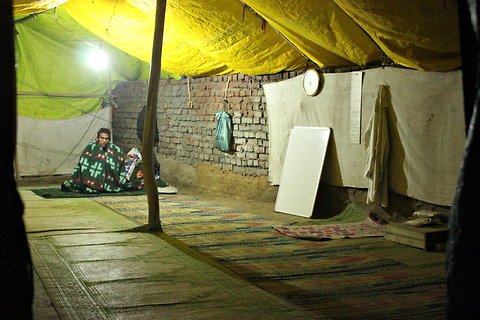NEW DELHI: The first time I met Noor Begum in 2012, she looked frightened. Why does the media want to know her story, she wondered aloud. Outside her small shack, made from rags and tin sheets, she sat gingerly to speak with me almost as if it was mandatory. Her shanty was a part of the makeshift refugee camp outside Kalindi Kunj on the Delhi-Noida border.
In 2012, when large scale communal violence engulfed Rakhine state of Myanmar thousands were killed and about 100,000 displaced. One morning, Begum saw her neighbour being burnt alive. The same night she picked up her 3-year-old and fled towards Bangladesh with her 7-year-old son tagging along. Her husband promised to follow them a few days later. After four harrowing weeks, she landed in Kalindi Kunj.
In November this year, she began preparing the refugee camp to receive more people from her state in Burma. A Rohinya militant group allegedly attacked and killed nine Myanmarese soldiers in October. In return, the army unleashed large-scale violence against the Rohingyas in Rakhine. Despite consistent international media reportage on the ruthlessness of the administration and forced migration of the rohingyas, violence has not abated. Neither has the mass exodus through Bangladesh to India and other countries.
About a thousand people came to Begum’s camp alone this November. Not all of them will stay there though. They get their refugee cards from the United Nations High Commission for Refugees and move to different locations in search of better living conditions. There are temporary make-shift camps in Assam, West Bengal, Uttar Pradesh, Andhra Pradesh, Karnataka, Delhi and Jammu.
The rivalry in the Indo-Pacific among India, China and Japan has ironically given the government of Myanmar bargaining power as the country is strategically located. These large powers of the region haven’t spoken out strongly against the violence against Rohingyas in Myanmar. However, the UN said that Myanmar was carrying out “ethnic cleansing” of Rohingya Muslims and Malayasian Prime Minister Najib Razak has referred to the action as “genocide”.
This has left more than 800,000 Rohingyas, who are not recognized as citizens by Myanmar, to fend for themselves in desperate conditions in refugee camps in other countries, making them one of the largest groups of stateless people in Asia. According to the United Nations, they are among the world’s most persecuted minorities.
The Buddhist Myanmarese government sees one million Rohingya population as illegal immigrants from Bangladesh, despite the fact that they have lived in the country for generations. Observers say the reason for such well-planned killings by the state are the huge oil reserves in Rakhine state.
Begum begins to excitedly talk to several people who arrive at the camp. She shows them where to fetch water from, helps them cook and ensures the kids have enough warm blankets to brave the Delhi cold. “I had no one to help me when I came here,” she said. “It is always nice to have someone to receive you.”
Her husband, Iftar Ahmed, who had promised to join his family in a week, only managed to come to the Bangladesh border. He was sent back to his village with beatings. He tried again after another year, and this time, he managed to reach Bangladesh. In Bangladesh, he ran out of money and did not enter India for four more months. He reunited with his family only in 2014.
“I know how difficult it is to even leave that place,” said Begum who had heard her husband’s story many times over. “So, if you have come to Delhi, it is a bigger deal than what you can imagine.”
As a destination for refugees, India has been very accommodative. As need arose, India welcomed Tibetans, Chakmas of Bangladesh, Afghans and ethnic Tamils from Sri Lanka. United Nations figures say, by the end of 2015, 2,07,861 “persons of concern” were in India. 2,01,281 of them were refugees and 6,480 were asylum seekers.
However, what happens to the refugees once they enter the country is a matter of concern. There is no uniform law that mandates the government on what should be done after a huge chunk of people enter the country as refugees. India has not signed the 1951 United Nations Refugee Convention on the Status of Refugees, or its 1967 UN Protocol that stipulates the rights and services host states must provide refugees. To add to it, the term ‘refugee’ is not mentioned in any domestic law.
Since there is a lack of legal clarity once they enter the borders, India’s fantastic open door policy when it comes to refugees and asylum seekers becomes contentious.
Random Acts like the The Passport (Entry of India) Act of 1920 and The Registration of Foreigners Act, 1939 come into play with regard to the fate of refugees and asylum seekers.
India houses about 10,000 Rohingyas, according to UNHCR. But, since Bangladesh has come down tougher on Rohingya settlers inside its border, more people like Begum are moving to India. Begum’s children now go to a local school, while she and her husband are waste pickers in near-by landfill. Their combined income, including a few odd jobs that they take in between, is about 8000 rupees a month. She says she is happy with the income. “We lived in constant fear in Myanmar,” she said. “Things are a lot better here.”
In March 2016, Rohingya Refugee Committee was formed in New Delhi, headed by a refugee Neza Mudden. He said it is meant to be a lobby group to help fellow-Rohingyas cut a better deal and stand united in emergency situations. “The Committee was formed because we know we are here for a long time, if not forever,” said Begum.
Many of inhabitants of the camp feel a sense of hopelessness even with the eight-month-old administration of Nobel Peace Prize winner Aung San Suu Kyi. “She can’t do anything,” concluded Begam.
Published in: The Citizen
Published on: 19 December, 2016
Link: http://www.thecitizen.in/index.php/en/NewsDetail/index/1/9475/Rohingya-Refugees-Lose-Faith-in-Aang-San-Suu-Kyi


